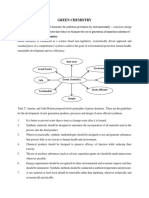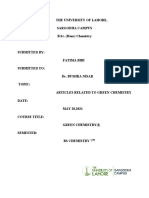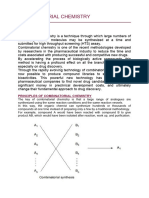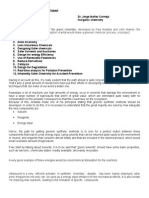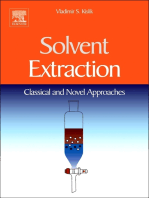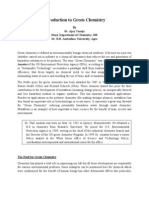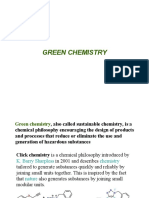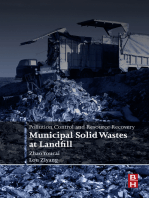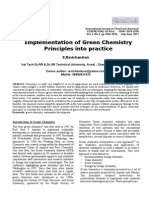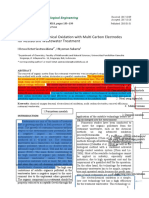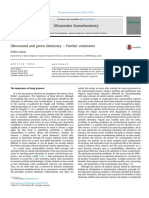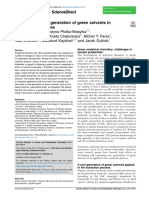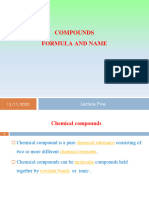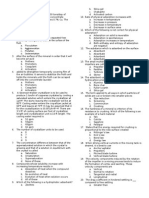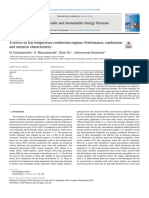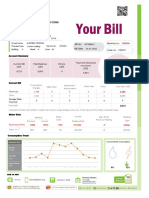Professional Documents
Culture Documents
Synthesis of Bromo Acid by Solvent and CatalystFree Reaction
Copyright
Available Formats
Share this document
Did you find this document useful?
Is this content inappropriate?
Report this DocumentCopyright:
Available Formats
Synthesis of Bromo Acid by Solvent and CatalystFree Reaction
Copyright:
Available Formats
Volume 8, Issue 4, April – 2023 International Journal of Innovative Science and Research Technology
ISSN No:-2456-2165
Synthesis of Bromo Acid by Solvent and Catalyst-
Free Reaction
Professor Shrikant Boharupi1,
1
Department of Pharmaceutical Chemistry
Sayali Tejam2,
Pratiksha Thakur2,
Sejal Patil2,
Purvaja Choudhary2,
Ashish Tiwari2,
2
NCRD’s Sterling Institute of Pharmacy, Sector-10, Nerul (E), Seawoods, Navi Mumbai, Maharashtra 40070
Abstract:- Chemistry is an extremely significant field of Objectives:
study. In the pharmaceutical industry chemistry plays an The main objectives of our research project are:
important role in formulating the drug. Nowadays ,
when a drug is to be synthesized everyone is looking To design a catalyst-free and solvent-free system to
towards the simple and non-tedious chemical reaction synthesize 3-bromo benzoic acid
which can be done by using less use of materials, In the To implement and promote green chemistry
past decades, the approach of making organic reactions To find out the novelty of the synthesized method
sustainable and innovative , various new methodologies To understand the chemistry of the desired product
by making it solvents or catalysts-free and applying Selection of the correct reaction method by trial-and-
alternative energy sources such as microwaves, error systems
sonication, conventional and room temperature heating
conditions, mechanochemical mixing, and high-speed Catalyst Free Organic Synthesis:
ball milling are becoming popular. All are approaching Catalysts usually promote faster chemical reactions
towards the Green Chemistry method which provides and for some reactions the desired selectivity
“Green” paths for different synthetic routes using non- (regioselectivity or chemo selectivity) can be obtained using
hazardous solvents and environmental- friendly specific selective sites of them. Conventional
chemicals. By application of this approach the synthesis catalysts/additives are usually associated with higher costs,
of bromo acids has been done using the sonication toxicity, and non-reusability and thereby generating more
process. wastes. From the green chemistry perspectives, significant
efforts have been made to improve overall applicability of
Keywords: Bromo Acid, Sonication, Green Chemistry, IR catalytic substances from suitable modifications and/or
Spectroscopy. innovation of new kinds of catalysts with multiple benefits.
However, the most useful way for designing an organic
I. INTRODUCTION reaction protocol without the aid of a catalyst. Catalyst-free
synthetic processes provide benefits to get rid of toxicity and
A solvent-free reaction may be carried out by using the wastes related with using these catalysts. Hence, designing
reactants alone or incorporating them with other safe of catalyst-free synthetic processes to improvise toward safe,
catalyst to attain high degree of stereoselectivity in the cost-effective, waste-free, simple, and sustainable
product, to reduce the by-product and to maximize the rate environment. It is often observed that suitably selected
of reaction. Solvent-less technology has many advantages starting materials can undergo self-catalysis in suitable
from the viewpoint of both academy and industry. Two of solvents (preferably in aqueous or aqueous ethanolic
twelve principles of “Green Chemistry” are “use of safer medium) in many conditions and/or the solvents can also
solvent and reactions condition” and to “prevent waste” and yield catalytic benefits to certain reaction processes from
both these principles are directly met by eliminating a their unique inherent properties. Reactions can also be
reaction medium. Solvent-free and/or solvent-less protocol promoted by using simple conventional heating in the
is frequently exhibiting remarkable rate of acceleration due presence or absence of solvent(s), and by the applications of
to the increased reaction conditions with some of them microwave irradiation, ultrasound irradiation and
occurring under ambient situation i.e., at room temperature, mechanochemical mixings.
microwave irradiation, ball milling etc.
Solvent Free Organic Synthesis:
Solvent-free synthesis is an alternative method to
traditional solution-based synthesis. Solvent-free synthesis
has various advantages over the traditional method of
IJISRT23APR653 www.ijisrt.com 599
Volume 8, Issue 4, April – 2023 International Journal of Innovative Science and Research Technology
ISSN No:-2456-2165
synthesis and that it is a type of green chemistry where little Sonication chemistry enhances or promotes chemical
or no solvents are used and environmentally friendly reactions and mass transfer and offers the advantage for
chemicals are used. The advantages of solvent-free reactions shorter reaction cycles, cheaper reagents, and less physical
are: conditions. Existing literature on sonication chemical
reacting systems is chemistry-intensive. Applications of this
Economic (cost saving, save money on solvent) novel method provides a means of reaction in
Not necessary to collect, purify, recycle, and remove environmentally friendly and pollution prevention which
solvent after completion of reaction. seem almost unlimited and is rapidly growing area.
Due to more availability of reactants, the reaction rate is
generally high. Experimental Details:
Environmentally friendly
Decreased of energy consumption Requirements: Conical flask, Glass rod, Spatula, Beaker,
Large reduction in batch size volume (reactor size) and Butter paper, Weighing machine, funnel, Whatmann
capital investment. filter paper, Sonicator
Chemicals: Benzoic acid LR, Benzoic acid extra pure,
Sonicator: Bromine liquid, KBrO3, Acetic acid, Ethanol, NaOH,
Sonication is the process of applying sound energy to conc. HNO3, AgNO3 solution, Na metal
agitate particles in a liquid. Ultrasonic frequencies greater
than 20 kHz is used; therefore the process is also known as II. PRINCIPLE
ultrasonication. Sonication can be done using either an
ultrasonic bath or an ultrasonic probe (sonicator) which The reaction of benzoic acid to m-bromobenzoic acid/
converts an electrical signal into a physical vibration to 3-bromo benzoic acid occurs through electrophilic
break substances apart. This interference can mix solutions, substitution reaction means the replacement of any of the
accelerate the dissolution of a solid into a liquid, such as atoms of a parent compound by an electrophile.
sugar into water, and remove dissolved gas from liquids. Electrophiles are electron loving species i.e.; they always
attack at the region of maximum electron density. If we
Sonication Process: draw the structure of benzoic acid, we will find that the pi
During sonication, cycles of pressure form thousands electrons of carbonyl group of COOH is in conjugation
of microscopic vacuum bubbles in the solution. The bubbles (alternate single and double bonds) with the pi electrons of
collapse into the solution in a process known as cavitation. the benzene ring. As a result, the pi electrons are delocalized
This causes powerful waves of vibration that release an (they move from their original positions) resulting into a
extensive energy force in the cavitation field, which disrupts number of structures which are in equilibrium with each
molecular interactions such as interactions between other. In each of these structures, either the ortho carbon or
molecules of water, separates clumps of particles, and the para carbon acquires a positive charge. It is only the
facilitates mixing. The energy from sound waves creates meta carbon that does not acquire positive charge. That is,
resistance in the solution, which creates heat. To stop a electron density always remains maximum at the meta
sample from heating up and degrading, keep it on ice before, position. So, it is quite natural that electrophile will always
during and after sonication. attack at the meta position. Therefore, electrophilic
substitution in benzoic acid always occurs at the meta
position.
Fig 1 Sonication Process
Green Aspects of Sonication Process:
Ultrasound- Assisted organic synthesis is applied in General Reaction of Converting α- Carboxylic Acid to
many organic synthetic routes with advantages such as- Bromo Derivative
High efficiency Hell-Volhard-Zelinsky Reaction:
Low waste Treatment of carboxylic acid with bromine and a
Low energy requirements catalytic amount of phosphorus leads to the selective α-
Ability to disperse reagent in small particles and bromination.
accelerate reactions
IJISRT23APR653 www.ijisrt.com 600
Volume 8, Issue 4, April – 2023 International Journal of Innovative Science and Research Technology
ISSN No:-2456-2165
Synthesis of m-bromo benzoic acid/ 3-bromo benzoic
acid takes place by reaction benzoic acid with Br2 and
FeBr3 as a catalyst.
As discuss earlier, the substitution of bromine at the
meta position occurs via electrophilic reaction.
The role of FeBr3 is to give the meta substituted bromo
benzoic acid.
Mechanism of the Hell-Volhard-Zelinsky Reaction:
Phosphorus reacts with bromine to give phosphorus Hazards of Bromine use:
tribromide, and this converts the carboxylic acid into an acyl May be harmful if swallowed.
bromide. Causes severe skin burns and eye damage.
Fatal if inhaled.
Precaution Taken During Handling of Bromine:
Do not breathe fume/gas/mist/vapours/spray.
Avoid release to the environment.
Wear protective gloves/protective clothing/eye
protection/face protection.
Wear respiratory protection.
An acyl bromide can readily exist in the enol form, and
this tautomer is rapidly brominated at the α-carbon. The Scheme 1:
mono brominated compound is much less nucleophilic, so 1.5 gm of Benzoic Acid LR + 5 ml of Bromine was
the reaction stops at this stage. This acyl intermediate taken in a beaker and the reaction was carried out in an open
compound can undergo bromide exchange with unreacted system. The beaker was placed in a Sonicator. Time Cycle
carboxylic acid via the anhydride, which allows the catalytic for the reaction to completion was 1 hr 20 min. At 30 min,
cycle to continue until the conversion is complete. white small crystals were started to form at inside the walls
of the beaker and water was added almost 2/4 th of the
beaker and heated for 15 min on Sonicator. After completion
of cycle, white solid crystals were formed and allowed to
settle down and filtered. Solid crystals were separated and
dried in hot air oven for 30 min at 80℃. Pale orange
coloured product was obtained. Qualitative tests were
performed on the crystals for detection of functional groups.
General Reaction of Converting Benzoic Acid to 3-
Bromo Benzoic Acid:
IJISRT23APR653 www.ijisrt.com 601
Volume 8, Issue 4, April – 2023 International Journal of Innovative Science and Research Technology
ISSN No:-2456-2165
Table 1 Preliminary Tests and Physical Evaluation for Scheme 1
Elemental Analysis:
It is a qualitative analysis of an unknown organic sample consists of detection of chemical composition i.e., Elements present
the organic sample. Carbon and hydrogen are main constituents. In addition to this samples contain sulphur, nitrogen, halogens
which can be detected by sodium fusion test, which is also known as Lessaignen’s test.
Lessaignen’s Test:
In this test the elements in the organic sample are converted into ionizable inorganic substances so that ionic tests can be
done for their detection.
Table 2 Lessaignen’s Test
IJISRT23APR653 www.ijisrt.com 602
Volume 8, Issue 4, April – 2023 International Journal of Innovative Science and Research Technology
ISSN No:-2456-2165
Detection of Functional Group:
Table 3 Tests for Carboxylic Groups
Conclusion:
As the required elemental group i.e., Bromine is not detected from the performed tests, this scheme fails to give the bromo
derivative of benzoic acid.
Scheme 2:
2 gm of Benzoic Acid + 5 ml of Bromine + 10 ml of ethanol in beaker was taken and placed on Sonicator. Time cycle
required for completion of reaction is 1 hr 10 min. As crystals were not seen in the beaker addition of 15ml of distilled water + 5
ml of ethanol was done to see whether the crystals are forming or not Again, placed on Sonicator for 30 min. No crystals were
obtained.
Conclusion:
As not product was obtained, this scheme fails.
Fig 2 Scheme 2
IJISRT23APR653 www.ijisrt.com 603
Volume 8, Issue 4, April – 2023 International Journal of Innovative Science and Research Technology
ISSN No:-2456-2165
Table 4 Preliminary Tests and Physical Evaluation for Scheme 2
Scheme 3:
1.5 gm of benzoic acid + 5 ml of bromine was taken in a conical flask and closed with the cotton plug to avoid escape of
bromine vapours. Conical flask was kept on Sonicator. Time cycle required for completion of reaction was 5 hr 30 min.
Intermittent shaking of flask was taken place during the process. After completion of process the product obtained was filtered and
separated. Solid crystals were separated and dried in hot air oven for 30 min at 80℃. Qualitative tests were performed on the
crystals for detection of functional groups.
Lessaignen’s Test:
In this test the elements in the organic sample are converted into ionizable inorganic substances so that ionic tests can be
done for their detection.
IJISRT23APR653 www.ijisrt.com 604
Volume 8, Issue 4, April – 2023 International Journal of Innovative Science and Research Technology
ISSN No:-2456-2165
Table 5 Lessaignen’s Test
Detection of Functional Group:
Table 6 Tests for Carboxylic Groups
IJISRT23APR653 www.ijisrt.com 605
Volume 8, Issue 4, April – 2023 International Journal of Innovative Science and Research Technology
ISSN No:-2456-2165
Conclusion: series of absorptions, frequently overlapping each other,
From the above tests performed it is concluded that the mainly due to all kinds of bending or stretching vibrations.
groups required in the desired product is confirmed. So this In group frequency region, the peaks corresponding to
scheme passes for the bromo derivative of benzoic acid. different functional groups can be observed. According to
corresponding peaks, functional group can be determined.
For more conformation of product FTIR is done for the Each atom of the molecule is connected by bond and each
compound. bond requires different IR region so characteristic peaks are
observed. This region of IR spectrum is called as finger print
Infrared Spectroscopy: region of the molecule. It can be determined by
Infrared spectroscopy is widely used in industry as characteristic peaks. Small differences in structure &
well as in research. IR is most useful in providing constitution of molecule can result in significant changes in
information about the presence or absence of specific the peaks in this region. Hence this region helps to identify
functional groups. Entire IR region is divided into group an unknown compound. The position and magnitudes of
frequency region and fingerprint region. Range of group peaks in the spectrum is compared with profiles of pure
frequency is 4000-1500 cm-1 while that of finger print compounds stored Identification is done based on position of
region is 1500-400 cm-1usually contains a very complicated absorption bands in the spectrum.
FTIR Spectra:
Fig 3 FTIR Spectra
IR Interpretation:
Fig 4 Spectrum Graph
IJISRT23APR653 www.ijisrt.com 606
Volume 8, Issue 4, April – 2023 International Journal of Innovative Science and Research Technology
ISSN No:-2456-2165
Table 7 IR Interpretation
From the above IR Spectrum graph, we have got the IR frequency of 705.52 cm-1 which is of Meta Disubstituted
Aromatic Compound.
By above IR interpretation data, it is now clear that the IR spectra of the groups containing in the product obtained is
confirm. Therefore, we concluded that the 3-bromo benzoic acid is obtained.
Scheme 4:
10.6 ml of Acetic Acid + 4g of KBrO3 + 6 ml of Bromine was taken in a conical flask and closed with the cotton plug to
avoid escape of bromine vapours. This conical flask was placed on sonicator. Time cycle for completion of the reaction was 7 hrs
Intermittent shaking of flask was taken place during the process. After completion of process the product obtained was filtered and
separated. Solid crystals were separated and dried in hot air oven for 30 min at 80℃ Qualitative tests were performed on the
crystals for detection of functional groups.
IJISRT23APR653 www.ijisrt.com 607
Volume 8, Issue 4, April – 2023 International Journal of Innovative Science and Research Technology
ISSN No:-2456-2165
Table 8 Preliminary Tests and Physical Evaluation for Scheme 4
Lessaigne’s Test:
Table 9 Lessaigne’s Test
Conclusion:
As bromine is not confirm through this test, this scheme fails to give the desired Product.
IJISRT23APR653 www.ijisrt.com 608
Volume 8, Issue 4, April – 2023 International Journal of Innovative Science and Research Technology
ISSN No:-2456-2165
III. RESULT & DISCUSSION REFERENCES
From the 4 schemes performed, only 3rd scheme was [1]. Ouellette, Robert J. (2014). Organic Chemistry ||
successful for giving the desired product i.e., 3-bromo Electrophilic Aromatic Substitution., (), 417-451.
benzoic acid. After confirmation physical & chemical Available form: https://doi.org/10.1016/B978-0-12-
properties of 3- bromo benzoic acid was determined and 800780-8.00013-9
reported. [2]. Dagani MJ, Barda HJ, Benya TJ, Sanders DC.
Bromine compounds. Ullmann's encyclopedia of
Compound: industrial chemistry. 2000 Jun 15. Available from:
https://onlinelibrary.wiley.com/doi/abs/10.1002/1435
6007.a04_405
[3]. Martínez RF, Cravotto G, Cintas P. Organic
Sonochemistry: A Chemist’s Timely Perspective on
Mechanisms and Reactivity. the Journal of Organic
Chemistry. 2021 Jun 22;86(20):13833-56. Available
from: https://dx.doi.org/10.1021%2Facs.joc.1c00805
[4]. Puri S, Kaur B, Parmar A, Kumar H. Applications of
ultrasound in organic synthesis-a green approach.
Current Organic Chemistry. 2013 Aug
1;17(16):1790-828. Available from:
http://dx.doi.org/10.2174/13852728113179990018
[5]. Crawford DE. Solvent-free sonochemistry:
Name - 3-bromo benzoic acid Sonochemical organic synthesis in the absence of a
Synonyms - m-bromo benzoic acid liquid medium. Beilstein journal of organic
Molecular Formula - C7H5BrO2 chemistry. 2017 Sep 4;13(1):1850-6. Available
Molecular Weight - 201.017 From: https://doi.org/10.3762/bjoc.13.179
Melting Point- 155 – 158 °C [6]. Dr. Dietmar Kennepohl FCIC (Professor of
Appearance (Form) - Powder or crystals Chemistry, Athabasca University), Prof. Steven
Appearance (Colour) - White to yellow Farmer (Sonoma State University), Layne Morsch
(University of Illinois Springfield).Alpha
Solubility - Insoluble in water Soluble in methanol
Bromination of Carboxylic Acids [Internet]. 2021
[cited 2022 May 7]. Available from:
Application
https://chem.libretexts.org/@go/page/36415
As test solute in the determination of acidity constants by
[7]. Dr.K.R.Mahadik, Dr.S.H.Bhosale:A Handbook of
capillary zone electrophoresis.
Practical Chemistry Inorganic and Organic
As internal standard to study the retention mechanisms Chemistry. Nirali Prakashan Publishers &
of an unmodified and a hydroxylated polystyrene- Distributers, Thirteen Edition, May 2016
divinylbenzene polymer by solid-phase extraction. [8]. Donald L. Pavia, Gary M. Lampman, George S. Kriz,
In synthesis of N-(1,1-dimethyl-2-hydroxyethyl)-3- James R. Vyvyan: Introduction to Spectroscopy.
bromobenzamide. Cengage Learning, Fifth Edition,2015
[9]. MERCK | INDIA – SIGMA-ALDRICH, 3-
IV. CONCLUSION Bromobenzoicacid. Available from: https://www.
Sigmaaldrich.Com/IN/ en/product/aldrich/186295
Various schemes were performed reacting the various [10]. PubChem [Internet]. Bethesda (MD): National
reagents at different volumes and different techniques. From Library of Medicine (US), National Center for
the above results, the scheme 3 was only successful to give Biotechnology Information; 2004-. PubChem
the product 3-bromo benzoic acid. Once the product was Compound Summary for CID 11456, 3-
obtained, firstly the preliminary tests and functional group Bromobenzoic acid; [cited 2022 May 7]. Available
detection test was done to confirm the groups present in the from: https://pubchem.ncbi.nlm.nih.gov/compound/
structure. For final confirmation Infrared Spectroscopy was 3-Bromobenzoic-acid
done on the product by which we came to conclusion that [11]. APPLICATIONS OF IR SPECTROSCOPY: Pharma
the desired product was obtained. As our main aim was to Tutor, 22 March 2010 Available From: https://www.
synthesize product by solvent and catalyst free, scheme 3 is pharmatutor.org/pharma-analysis/analytical-aspects-
best fit for these results and successful. The schemes of-infra-redspectroscopy-ir/application-ir-
performed follow the principles given in the green chemistry spectrophotometry
and the techniques used was by sonication. By the trial-and-
error system, new method of synthesizing the product is
formed which is novel and there is no evidence of this in any
literature. The conclusion of this project is that the 3-bromo
benzoic acid is synthesize by solvent and catalyst free
reaction which is Novel and a Green Method.
IJISRT23APR653 www.ijisrt.com 609
You might also like
- The Principles of Green ChemistryDocument4 pagesThe Principles of Green Chemistryrk_gummaluri5334No ratings yet
- The Why?: AcknowledgementDocument8 pagesThe Why?: AcknowledgementADITYANo ratings yet
- 1 s2.0 S0165993617300870 MainDocument14 pages1 s2.0 S0165993617300870 MainAldo RamirezNo ratings yet
- LABOR ORGANIC SYNTHES GREEN CHEM METHODS 2010 Green Chemistry 06 - 10 - 2010Document13 pagesLABOR ORGANIC SYNTHES GREEN CHEM METHODS 2010 Green Chemistry 06 - 10 - 2010Luiz Rodrigo AssisNo ratings yet
- Biofiltration of Volatile Organic Compounds (Vocs) - An OverviewDocument10 pagesBiofiltration of Volatile Organic Compounds (Vocs) - An OverviewHairunisa AgnowaraNo ratings yet
- Articles Related To Green ChemistryDocument11 pagesArticles Related To Green ChemistryAlina SajjadNo ratings yet
- Molecules 29 00398Document25 pagesMolecules 29 00398asif manzoorNo ratings yet
- Bio OxidationDocument16 pagesBio Oxidationaditshirke135No ratings yet
- Extraction With Environmentally Friendly SolventsDocument14 pagesExtraction With Environmentally Friendly Solventsbabder1235No ratings yet
- Advanced Oxidation Processes Integrated by Membrane Reactors andDocument15 pagesAdvanced Oxidation Processes Integrated by Membrane Reactors andErickNo ratings yet
- Combinatorial ChemistryDocument5 pagesCombinatorial Chemistrybrendadsouza235No ratings yet
- Green Chemistry SummaryDocument2 pagesGreen Chemistry Summaryjgeorge095No ratings yet
- 06 Green Chemistry 06 - 10 - 2010Document12 pages06 Green Chemistry 06 - 10 - 2010Saurav GuptaNo ratings yet
- Module 4Document11 pagesModule 4yiyiyi7699No ratings yet
- Review On Recent Technologies For Industrial Wastewater TreatmentDocument8 pagesReview On Recent Technologies For Industrial Wastewater TreatmentIJRASETPublicationsNo ratings yet
- Fermentation 20190426132559Document22 pagesFermentation 20190426132559JivashiniBalasupurManiamNo ratings yet
- Journal of Environmental Science and Engineering, Vol.7, No.4B, 2018Document48 pagesJournal of Environmental Science and Engineering, Vol.7, No.4B, 2018Anonymous kqqWjuCG9No ratings yet
- Green Chemistry 2Document20 pagesGreen Chemistry 2Caloris BasinNo ratings yet
- Green Chemistry: September 2021Document26 pagesGreen Chemistry: September 2021Subhasish DashNo ratings yet
- Concept of Green ChemistryDocument8 pagesConcept of Green ChemistryGupta BDNo ratings yet
- Green Chemistry Lecture 1 & 2Document25 pagesGreen Chemistry Lecture 1 & 2Muhammad IrshadNo ratings yet
- Microwave-Assisted Synthesis and Photochemical Reactions of Some Novel Organosulfur Compounds Relevant To Green ChemistryDocument15 pagesMicrowave-Assisted Synthesis and Photochemical Reactions of Some Novel Organosulfur Compounds Relevant To Green ChemistryDr. K.P.SrivastavaNo ratings yet
- Role of Chemistry in Environmental Protection and Economic DevelopmentDocument6 pagesRole of Chemistry in Environmental Protection and Economic Developmentrimo1567% (6)
- Solvent Extraction: Classical and Novel ApproachesFrom EverandSolvent Extraction: Classical and Novel ApproachesRating: 4 out of 5 stars4/5 (2)
- Accepted Manuscript: Ultrasonics SonochemistryDocument32 pagesAccepted Manuscript: Ultrasonics SonochemistryIshu TyagiNo ratings yet
- Accepted Manuscript: Ultrasonics SonochemistryDocument32 pagesAccepted Manuscript: Ultrasonics SonochemistryIshu TyagiNo ratings yet
- Introduction To Green ChemistryDocument10 pagesIntroduction To Green ChemistryMihaela Sarateanu BiltacNo ratings yet
- Molecules 26 02241Document19 pagesMolecules 26 02241SHELLA VERINA PUTRI I2O27OO6ONo ratings yet
- Challenges and Emerging Trends in Advanced Oxidation Technologies and Integration of Advanced Oxidation Processes With Biological Processes For Wastewater TreatmentDocument27 pagesChallenges and Emerging Trends in Advanced Oxidation Technologies and Integration of Advanced Oxidation Processes With Biological Processes For Wastewater TreatmenthodcivilssmietNo ratings yet
- How Green Can Reduce Environmental PollutionDocument6 pagesHow Green Can Reduce Environmental PollutionMUHAMAD HAMMAD AHMEDNo ratings yet
- Green TechnologyDocument23 pagesGreen Technologyaggarwalsaksham245No ratings yet
- Brønsted Acid Catalyzed Mechanochemical Domino Multicomponent Reactions by Employing Liquid Assisted Grindstone ChemistryDocument17 pagesBrønsted Acid Catalyzed Mechanochemical Domino Multicomponent Reactions by Employing Liquid Assisted Grindstone ChemistrysciCatNo ratings yet
- Final Thesis ChetnaDocument63 pagesFinal Thesis ChetnaÖmer LaçinNo ratings yet
- Proposal 14.08.2023Document6 pagesProposal 14.08.2023gopiNo ratings yet
- GreenDocument16 pagesGreenGopal SharmaNo ratings yet
- A Review On The Factors Affecting The Photocatalytic Degradation of Hazardous MaterialsDocument9 pagesA Review On The Factors Affecting The Photocatalytic Degradation of Hazardous Materialshakam halimNo ratings yet
- Chapter 1Document20 pagesChapter 1Manan RathodNo ratings yet
- 225 286 JMTR Oct2016 PDFDocument66 pages225 286 JMTR Oct2016 PDFKevinNo ratings yet
- Waste Water MNMTDocument12 pagesWaste Water MNMTCiddarthnNo ratings yet
- Pollution Control and Resource Recovery: Municipal Solid Wastes at LandfillFrom EverandPollution Control and Resource Recovery: Municipal Solid Wastes at LandfillNo ratings yet
- Green Chemistry - A Sustainable ChemistryDocument10 pagesGreen Chemistry - A Sustainable ChemistryCentral Asian StudiesNo ratings yet
- Sustainable Resource Recovery and Zero Waste ApproachesFrom EverandSustainable Resource Recovery and Zero Waste ApproachesMohammad TaherzadehNo ratings yet
- Biofiltration of Volatile Organic Compounds (Vocs) - An OverviewDocument10 pagesBiofiltration of Volatile Organic Compounds (Vocs) - An OverviewbaanniiNo ratings yet
- Supercritical Fluid Technology: Green Chemistry For The 21 CenturyDocument6 pagesSupercritical Fluid Technology: Green Chemistry For The 21 CenturyGanesamoorthy ThirunarayananNo ratings yet
- Abstract:: Keywords: Drug Design, Drug Discovery, Green ChemistryDocument5 pagesAbstract:: Keywords: Drug Design, Drug Discovery, Green ChemistryRajendra SinhaNo ratings yet
- E BookDocument254 pagesE BookerickjarlesNo ratings yet
- Unit 3 ChemistryDocument112 pagesUnit 3 ChemistryAjawin EmmanuelNo ratings yet
- IJCRT2201535Document20 pagesIJCRT2201535payal_joshi_14No ratings yet
- Green Chemistry Essay PDFDocument7 pagesGreen Chemistry Essay PDFm2_zakyNo ratings yet
- Green Analytical Chemistry and Its Perspectives in Bulgaria: E. H. Ivanova, A. K. DetchevaDocument54 pagesGreen Analytical Chemistry and Its Perspectives in Bulgaria: E. H. Ivanova, A. K. DetchevaAndra AlNo ratings yet
- 24.8.18 GctiDocument112 pages24.8.18 GctiReena SinghalNo ratings yet
- Green Chemistry PracticeDocument4 pagesGreen Chemistry PracticefanthiNo ratings yet
- 'Industrial Organic Chemistry-Class-2021-22 (Autosaved) 'Document137 pages'Industrial Organic Chemistry-Class-2021-22 (Autosaved) 'shiveshverma11No ratings yet
- JEE (Scopus Q3)Document7 pagesJEE (Scopus Q3)angginoviariNo ratings yet
- Ultrasonics Sonochemistry: Pedro CintasDocument2 pagesUltrasonics Sonochemistry: Pedro CintasFitra Isni RositaNo ratings yet
- Emerging Trends in Chemical and Biochemical Engineering-Volume 2Document108 pagesEmerging Trends in Chemical and Biochemical Engineering-Volume 2shailendra pandeyNo ratings yet
- Detoxification of Malachite Green and Textile Industrial Ef Uent by Penicillium OchrochloronDocument10 pagesDetoxification of Malachite Green and Textile Industrial Ef Uent by Penicillium OchrochloronJuan Diego CárdenasNo ratings yet
- Magnetic Nanoparticle Based CatalystDocument3 pagesMagnetic Nanoparticle Based CatalystIsabel GarcíaNo ratings yet
- TerpenesDocument11 pagesTerpenesarooj sheikhNo ratings yet
- An Industry That Capitalizes Off of Women's Insecurities?Document8 pagesAn Industry That Capitalizes Off of Women's Insecurities?International Journal of Innovative Science and Research TechnologyNo ratings yet
- Study Assessing Viability of Installing 20kw Solar Power For The Electrical & Electronic Engineering Department Rufus Giwa Polytechnic OwoDocument6 pagesStudy Assessing Viability of Installing 20kw Solar Power For The Electrical & Electronic Engineering Department Rufus Giwa Polytechnic OwoInternational Journal of Innovative Science and Research TechnologyNo ratings yet
- Forensic Advantages and Disadvantages of Raman Spectroscopy Methods in Various Banknotes Analysis and The Observed Discordant ResultsDocument12 pagesForensic Advantages and Disadvantages of Raman Spectroscopy Methods in Various Banknotes Analysis and The Observed Discordant ResultsInternational Journal of Innovative Science and Research TechnologyNo ratings yet
- Cyber Security Awareness and Educational Outcomes of Grade 4 LearnersDocument33 pagesCyber Security Awareness and Educational Outcomes of Grade 4 LearnersInternational Journal of Innovative Science and Research TechnologyNo ratings yet
- Blockchain Based Decentralized ApplicationDocument7 pagesBlockchain Based Decentralized ApplicationInternational Journal of Innovative Science and Research TechnologyNo ratings yet
- Factors Influencing The Use of Improved Maize Seed and Participation in The Seed Demonstration Program by Smallholder Farmers in Kwali Area Council Abuja, NigeriaDocument6 pagesFactors Influencing The Use of Improved Maize Seed and Participation in The Seed Demonstration Program by Smallholder Farmers in Kwali Area Council Abuja, NigeriaInternational Journal of Innovative Science and Research TechnologyNo ratings yet
- Unmasking Phishing Threats Through Cutting-Edge Machine LearningDocument8 pagesUnmasking Phishing Threats Through Cutting-Edge Machine LearningInternational Journal of Innovative Science and Research TechnologyNo ratings yet
- Insights Into Nipah Virus: A Review of Epidemiology, Pathogenesis, and Therapeutic AdvancesDocument8 pagesInsights Into Nipah Virus: A Review of Epidemiology, Pathogenesis, and Therapeutic AdvancesInternational Journal of Innovative Science and Research TechnologyNo ratings yet
- Keywords:-Ibadhy Chooranam, Cataract, Kann Kasam,: Siddha Medicine, Kann NoigalDocument7 pagesKeywords:-Ibadhy Chooranam, Cataract, Kann Kasam,: Siddha Medicine, Kann NoigalInternational Journal of Innovative Science and Research TechnologyNo ratings yet
- Visual Water: An Integration of App and Web To Understand Chemical ElementsDocument5 pagesVisual Water: An Integration of App and Web To Understand Chemical ElementsInternational Journal of Innovative Science and Research TechnologyNo ratings yet
- Impact of Silver Nanoparticles Infused in Blood in A Stenosed Artery Under The Effect of Magnetic Field Imp. of Silver Nano. Inf. in Blood in A Sten. Art. Under The Eff. of Mag. FieldDocument6 pagesImpact of Silver Nanoparticles Infused in Blood in A Stenosed Artery Under The Effect of Magnetic Field Imp. of Silver Nano. Inf. in Blood in A Sten. Art. Under The Eff. of Mag. FieldInternational Journal of Innovative Science and Research TechnologyNo ratings yet
- Parastomal Hernia: A Case Report, Repaired by Modified Laparascopic Sugarbaker TechniqueDocument2 pagesParastomal Hernia: A Case Report, Repaired by Modified Laparascopic Sugarbaker TechniqueInternational Journal of Innovative Science and Research TechnologyNo ratings yet
- Smart Health Care SystemDocument8 pagesSmart Health Care SystemInternational Journal of Innovative Science and Research TechnologyNo ratings yet
- Compact and Wearable Ventilator System For Enhanced Patient CareDocument4 pagesCompact and Wearable Ventilator System For Enhanced Patient CareInternational Journal of Innovative Science and Research TechnologyNo ratings yet
- Smart Cities: Boosting Economic Growth Through Innovation and EfficiencyDocument19 pagesSmart Cities: Boosting Economic Growth Through Innovation and EfficiencyInternational Journal of Innovative Science and Research TechnologyNo ratings yet
- Air Quality Index Prediction Using Bi-LSTMDocument8 pagesAir Quality Index Prediction Using Bi-LSTMInternational Journal of Innovative Science and Research TechnologyNo ratings yet
- Predict The Heart Attack Possibilities Using Machine LearningDocument2 pagesPredict The Heart Attack Possibilities Using Machine LearningInternational Journal of Innovative Science and Research TechnologyNo ratings yet
- Quantifying of Radioactive Elements in Soil, Water and Plant Samples Using Laser Induced Breakdown Spectroscopy (LIBS) TechniqueDocument6 pagesQuantifying of Radioactive Elements in Soil, Water and Plant Samples Using Laser Induced Breakdown Spectroscopy (LIBS) TechniqueInternational Journal of Innovative Science and Research TechnologyNo ratings yet
- Implications of Adnexal Invasions in Primary Extramammary Paget's Disease: A Systematic ReviewDocument6 pagesImplications of Adnexal Invasions in Primary Extramammary Paget's Disease: A Systematic ReviewInternational Journal of Innovative Science and Research TechnologyNo ratings yet
- Harnessing Open Innovation For Translating Global Languages Into Indian LanuagesDocument7 pagesHarnessing Open Innovation For Translating Global Languages Into Indian LanuagesInternational Journal of Innovative Science and Research TechnologyNo ratings yet
- An Analysis On Mental Health Issues Among IndividualsDocument6 pagesAn Analysis On Mental Health Issues Among IndividualsInternational Journal of Innovative Science and Research TechnologyNo ratings yet
- Parkinson's Detection Using Voice Features and Spiral DrawingsDocument5 pagesParkinson's Detection Using Voice Features and Spiral DrawingsInternational Journal of Innovative Science and Research TechnologyNo ratings yet
- Investigating Factors Influencing Employee Absenteeism: A Case Study of Secondary Schools in MuscatDocument16 pagesInvestigating Factors Influencing Employee Absenteeism: A Case Study of Secondary Schools in MuscatInternational Journal of Innovative Science and Research TechnologyNo ratings yet
- The Utilization of Date Palm (Phoenix Dactylifera) Leaf Fiber As A Main Component in Making An Improvised Water FilterDocument11 pagesThe Utilization of Date Palm (Phoenix Dactylifera) Leaf Fiber As A Main Component in Making An Improvised Water FilterInternational Journal of Innovative Science and Research TechnologyNo ratings yet
- Dense Wavelength Division Multiplexing (DWDM) in IT Networks: A Leap Beyond Synchronous Digital Hierarchy (SDH)Document2 pagesDense Wavelength Division Multiplexing (DWDM) in IT Networks: A Leap Beyond Synchronous Digital Hierarchy (SDH)International Journal of Innovative Science and Research TechnologyNo ratings yet
- The Making of Object Recognition Eyeglasses For The Visually Impaired Using Image AIDocument6 pagesThe Making of Object Recognition Eyeglasses For The Visually Impaired Using Image AIInternational Journal of Innovative Science and Research TechnologyNo ratings yet
- The Relationship Between Teacher Reflective Practice and Students Engagement in The Public Elementary SchoolDocument31 pagesThe Relationship Between Teacher Reflective Practice and Students Engagement in The Public Elementary SchoolInternational Journal of Innovative Science and Research TechnologyNo ratings yet
- Advancing Healthcare Predictions: Harnessing Machine Learning For Accurate Health Index PrognosisDocument8 pagesAdvancing Healthcare Predictions: Harnessing Machine Learning For Accurate Health Index PrognosisInternational Journal of Innovative Science and Research TechnologyNo ratings yet
- Diabetic Retinopathy Stage Detection Using CNN and Inception V3Document9 pagesDiabetic Retinopathy Stage Detection Using CNN and Inception V3International Journal of Innovative Science and Research TechnologyNo ratings yet
- Terracing As An Old-Style Scheme of Soil Water Preservation in Djingliya-Mandara Mountains - CameroonDocument14 pagesTerracing As An Old-Style Scheme of Soil Water Preservation in Djingliya-Mandara Mountains - CameroonInternational Journal of Innovative Science and Research TechnologyNo ratings yet
- Roquette Sds Us Pearlitol-Cr-H 000000202191 enDocument6 pagesRoquette Sds Us Pearlitol-Cr-H 000000202191 enKishoreNo ratings yet
- The Periodic Table Chemical Periodicity (Paper-01) WYDocument16 pagesThe Periodic Table Chemical Periodicity (Paper-01) WYgreedy AsunaNo ratings yet
- Study of HEPs of HimachalDocument75 pagesStudy of HEPs of HimachalBhavesh KaushalNo ratings yet
- Ennore SEZ - English 17.10.17Document2 pagesEnnore SEZ - English 17.10.17Rísês ÃfrözNo ratings yet
- Review Questions Key 2010Document59 pagesReview Questions Key 2010Aleya NajihaNo ratings yet
- EVOLUTION REDUX ReadingDocument3 pagesEVOLUTION REDUX ReadingThuna BhabaNo ratings yet
- English IX FinalDocument10 pagesEnglish IX Finalmona_1327No ratings yet
- Chemistry G10 12Document92 pagesChemistry G10 12Fredson kalinda100% (1)
- Cap4 Composite Materials For Wind Turbine BladesDocument9 pagesCap4 Composite Materials For Wind Turbine BladesSilvio NunesNo ratings yet
- Primary and Secondary Geochemical Dispersion PatternsDocument2 pagesPrimary and Secondary Geochemical Dispersion PatternsTREVOR MAVUNGANo ratings yet
- CompoundsDocument31 pagesCompoundstalalzoqmat2003No ratings yet
- 04 BoilersDocument59 pages04 BoilersMHD Abdi MuttaqinNo ratings yet
- Physical Geology QuestionsDocument13 pagesPhysical Geology QuestionsCarlAngeloSoleeNo ratings yet
- Arban, CG. Lesson Plan in Geothermal Energy, 11 - STEMDocument6 pagesArban, CG. Lesson Plan in Geothermal Energy, 11 - STEMCzarina Amor CabilleteNo ratings yet
- Periodic Classification - Mind Maps - Arjuna JEE 2.0 2024Document1 pagePeriodic Classification - Mind Maps - Arjuna JEE 2.0 2024Harsh Singh RajputNo ratings yet
- Day 2 Chemical Engineering MCQsDocument2 pagesDay 2 Chemical Engineering MCQsRexel Reedus100% (1)
- Electrochemical Compression 2018Document19 pagesElectrochemical Compression 2018Carlos MarquezNo ratings yet
- MS Samsung Ar9000 Inverter AirconditioningDocument2 pagesMS Samsung Ar9000 Inverter AirconditioningMacSparesNo ratings yet
- LTC Review PDFDocument53 pagesLTC Review PDFKannan ChidambaramNo ratings yet
- Cha 12Document9 pagesCha 12Tun Lin AungNo ratings yet
- QB Ch22Document17 pagesQB Ch22tateNo ratings yet
- Structural and Defect Properties of The Lapo and Lap O - Based Proton ConductorsDocument7 pagesStructural and Defect Properties of The Lapo and Lap O - Based Proton ConductorsEstudiante2346No ratings yet
- X-Ray Diffraction and Clay Mineral IdentificationDocument392 pagesX-Ray Diffraction and Clay Mineral IdentificationSambit Shuvankar PandaNo ratings yet
- Otto & Diesel ProblemsDocument2 pagesOtto & Diesel ProblemsRimarkZanoriaNo ratings yet
- Eppen Lysine 98% MSDSDocument7 pagesEppen Lysine 98% MSDSEva NuñezNo ratings yet
- 1.the Structure of The EarthDocument26 pages1.the Structure of The EarthKazi ImeliNo ratings yet
- PLAN 4 - Senior 1 PhysicsDocument20 pagesPLAN 4 - Senior 1 PhysicspazzagliacarmelaNo ratings yet
- Siddaganga Institute of Technology, Tumkur - 572 103Document1 pageSiddaganga Institute of Technology, Tumkur - 572 103Sachin Krishna Moger 1si17ch026No ratings yet
- Tuyen Sinh Lop 10 Chuyen 2012-2013Document4 pagesTuyen Sinh Lop 10 Chuyen 2012-2013Thinh LeNo ratings yet
- Your Bill: Galfar Almisnad Engineering CongDocument2 pagesYour Bill: Galfar Almisnad Engineering CongShuhaib MukkolyNo ratings yet
